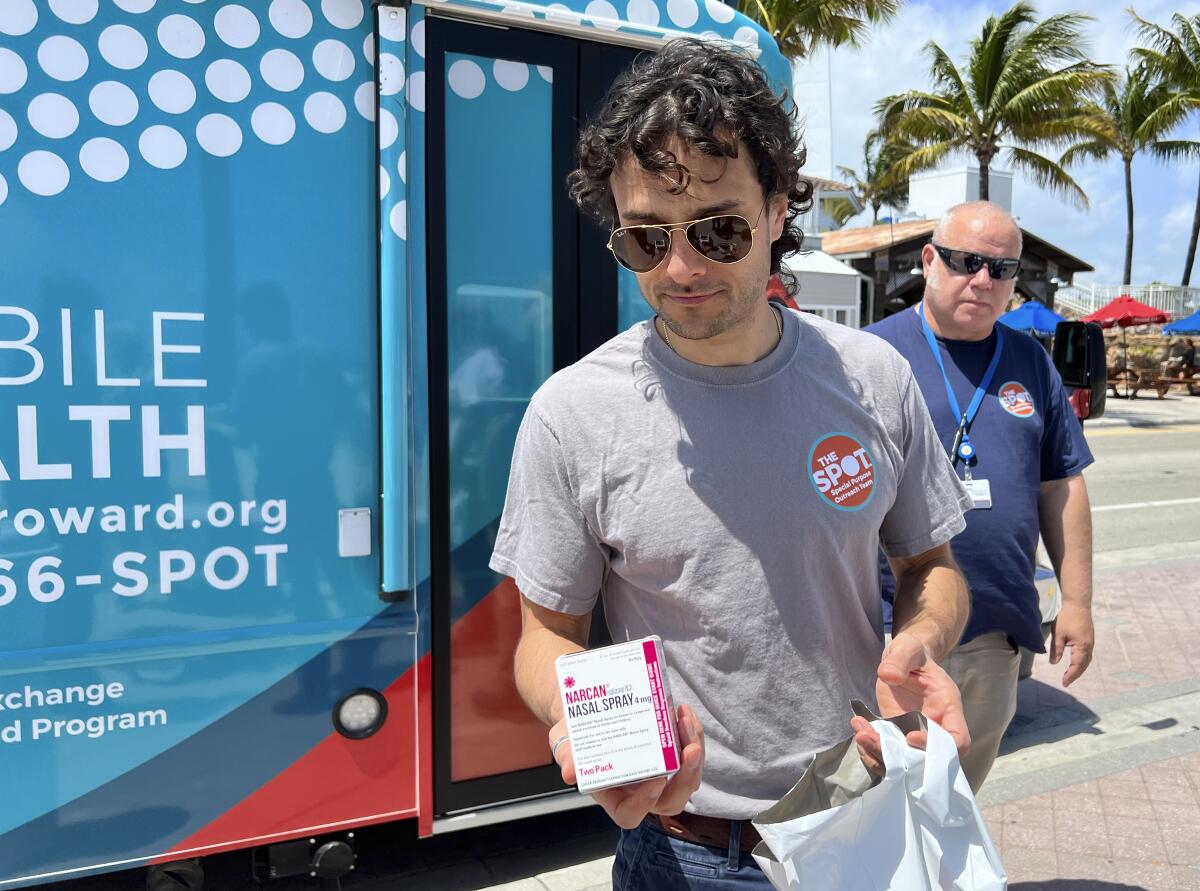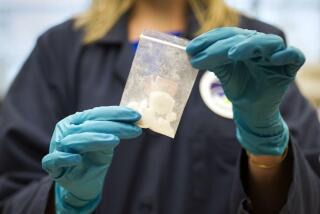Florida groups canvass spring breakers to warn of fentanyl

FORT LAUDERDALE, Fla. — In the days after a group of West Point cadets on spring break were sickened by fentanyl-laced cocaine at a South Florida house party, community activists sprang into action.
They blitzed beaches, warned spring breakers of a surge in recreational drugs cut with the dangerous synthetic opioid and offered an antidote for overdoses, which have risen nationally during the COVID-19 pandemic.
Street teams stood under the blistering sun, handing out beads, pamphlets and samples of naloxone, a drug known by the brand name Narcan, which can revive overdose victims.
“We weren’t sure how people would react,” said Thomas Smith, director of behavioral health services for the Special Purpose Outreach Team, a local mobile medical program. “But the spring breakers have been great. Some say, ‘I don’t do drugs, but my buddy sometimes does something stupid.’ They are happy to get Narcan.”
Smith’s team pulls up to Fort Lauderdale beach in a brightly colored mobile clinic van. They walk the sidewalks that run parallel to the beach, across the main drag from the bustling oceanfront clubs and restaurants.
“Have you heard of Narcan?” Huston Ochoa, a clinical counselor for the SPOT, asked Tristan Gentles on a recent afternoon as music blared from the Elbo Room, a bar at the heart of Fort Lauderdale Beach.
Gentles, who worked as a bartender and bouncer in New York City before moving to Fort Lauderdale, said he appreciates their efforts.
“There’s only so much you can do when you see someone on the floor,” he said, adding that he had witnessed numerous overdoses during his days in New York.
Fentanyl and other synthetic drugs, which can be 50 to 100 times more potent than heroin or prescription opioids, are what make the overdoses so dangerous, said David Scharf, who oversees community programs for the Broward Sheriff’s Office and is the chairman of the county’s Opioid Community Response Team.
Last year, the U.S. Centers for Disease Control and Prevention reported that for the first time more than 100,000 Americans had died of drug overdoses over a 12-month period. About two-thirds of the deaths were linked to fentanyl and other synthetic drugs. Stress from the COVID-19 pandemic and the use of fentanyl are considered factors in the increase in deaths, according to preliminary reports by the CDC.
Broward County led the state in fentanyl deaths in 2020, the latest year for which statistics are available from the Florida Medical Examiners Commission. In the vast majority of the deaths, fentanyl was combined with another drug, the sheriff’s office said.
“One snort, one swallow, one shot can kill,” said Jim Hall, a retired epidemiologist from Nova Southeastern University, who has worked with the county’s opioid response team. “It is not just in Florida but anywhere in North America.”
For the first three months of 2022, Fort Lauderdale Fire Rescue responded to 373 calls involving a possible overdose, where Narcan was administered, Battalion Chief Stephen Gollan said. That’s an average of more than four per day.
The reaction in Broward was swift after the five U.S. Military Academy cadets overdosed in Wilton Manors on March 10, just as thousands of college students were heading to Fort Lauderdale for spring break.
The following Monday, more than 100 people representing agencies from law enforcement to social service organizations and hospitals met via Zoom to devise a plan to keep spring breakers safe.
Groups such as the SPOT and the South Florida Wellness Network, which partner with the United Way of Broward County, agreed to hit the beaches to talk with people about the dangers associated with fentanyl-laced drugs. They also talked to restaurant and bar owners who could distribute Narcan if “someone went down,” Scharf said.
The groups have so far distributed more than 2,000 doses of Narcan supplied by state grants. The SPOT volunteers handed out packages with two doses of the nasal spray plus instructions.
“It was kind of a blitz operation to get out there as quickly as possible, and to get as much information and Narcan out on the streets,” Scharf said.
The volunteer groups and sheriff’s office don’t have figures on how many of the distributed doses were actually used but believe the program has succeeded in raising awareness.
The region isn’t yet out of the spring break period, which runs until mid-April, but Scharf said organizers have been heartened to see a couple of weekends pass without any overdoses that resulted in emergency calls.
“We had zero, which is like the first time in forever that we had none,” Scharf said.
“We had a terrible situation,” with overdoses of the cadets and others, and turned it into “an opportunity to really beef up our education and prevention efforts by flooding the beaches and the streets,” Scharf said.
Smith, of the SPOT, said spring breakers were “grateful and appreciative” and his group now has to plan how to “keep the momentum going.”
To that end, the street teams plan to continue working events that bring in large crowds, such as the weekend’s sold-out Tortuga Music Festival on Fort Lauderdale Beach.
“It’s about saving lives,” said Emy Martinez, who manages a safe syringe program for the SPOT. “It’s all about saving one life at a time.”
More to Read
Sign up for Essential California
The most important California stories and recommendations in your inbox every morning.
You may occasionally receive promotional content from the Los Angeles Times.









